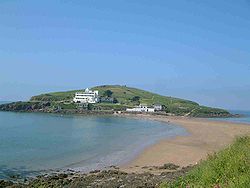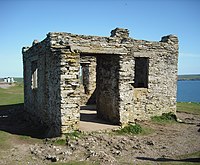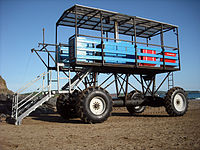Burgh Island
| Burgh Island | |
 View from Bigbury-on-Sea | |
|---|---|
| Location | |
| Grid reference: | SX646439 |
| Data | |
Burgh Island is a small tidal island off the coast of south Devon near to the small seaside village of Bigbury-on-Sea. There are several buildings on the island, the largest being the Art Deco Burgh Island Hotel. The other buildings are three private houses, and a public house, the Pilchard Inn, run by the hotel.
History
The early history of the island is unclear, however it is mentioned in early records and on maps as St Michael's Island. Later the name changed to Borough Island, eventually being corrupted to Burgh. As late as 1947 an Ordnance Survey map refers to the island as Borough Island. In 1908 a postcard produced by Stengel & Co Ltd of London [1] referred to it as Burr Island. A map published in 1765 shows "Borough or Bur Isle".[2]

It is believed a monastery was established on the island, most of the remains of which may lie beneath the current hotel. The ancient Pilchard Inn may have started life as the guest lodgings for the monastery.
A small, perhaps transient, population of fishermen occupied the island following the dissolution of the monastery, specialising in pilchard fishing. There are the remains of a chapel a-top the island, which was later became a "huers hut" — a place where fishermen would make a "hue and cry" call to inform other fishermen of shoals of pilchards.[3] During this period smuggling, wrecking and piracy were common, benefiting from a natural barrier for half the day.
Fears of German landing forces using the island as a beachhead during Second World War resulted in the area's fortification with anti-tank defences as well as two pill boxes, positioned on either side of the causeway. An observation post was also established on the summit to monitor the coastline.
The hotel
 Burgh Island is well-known today as the location of a restored 1920s Art Deco style hotel.
Burgh Island is well-known today as the location of a restored 1920s Art Deco style hotel.
Burgh Island is closely linked to Agatha Christie, as it served as the inspirational setting for both And Then There Were None as well as the Hercule Poirot mystery Evil Under the Sun. The 2002 TV adaptation of Evil Under The Sun used the island as a filming location. In 1994 an episode of the television series Lovejoy was set and filmed on the island. It was entitled 'Somewhere Over the Rainbow'. The island was also the location for GMTV's Inch-loss Island slimming feature in 2008, as it was for the original series in 2001. The climactic scene of the 1965 British film "Catch Us If You Can" (featuring The Dave Clark Five) takes place at the island.
Visits

The island is approximately 270 yards from the mainland at Bigbury-on-Sea and is approachable on foot at low tide. At high tide, a sea tractor, which is operated by the hotel, transports passengers back and forth. The original vehicle was constructed in 1930; the current, third generation tractor dates from 1969. The vehicle drives across the beach with its wheels underwater on the sandy bottom while its driver and passengers sit on a platform high above. Power from a Fordson tractor engine is relayed to the wheels by way of hydraulic motors.
Footpaths
The island has an extensive network of footpaths and the owner until 2003 was a keen hiker who welcomed walkers. The new owners, however, erected signs closing footpaths and obtained an exemption from the public "rights to roam" enabled in the Countryside and Rights of Way Act 2000. The exemption was overturned, except for the routes closest to the hotel, in 2006.[4]
Outside links
| ("Wikimedia Commons" has material about Island Burgh Island) |
References
- ↑ Stengel & Co Ltd, London EC; card reference E32111; The Warren from Burr Island
- ↑ Donn, Benjamin (1765). "A map of the county of Devon, 1765. Section SX64.". Devon Libraries Local Studies Service. Devon County Council. http://www.devon.gov.uk/localstudies/100647/2.html. Retrieved 2009-06-18.
- ↑ "Burgh Island Galleries". The BBC. http://www.bbc.co.uk/devon/content/image_galleries/burgh_island_gallery.shtml?11. Retrieved 2009-04-15.
- ↑ Staff writer (2 December 2006). "Walkers are free to use island paths". Western Morning News: p. 30.
